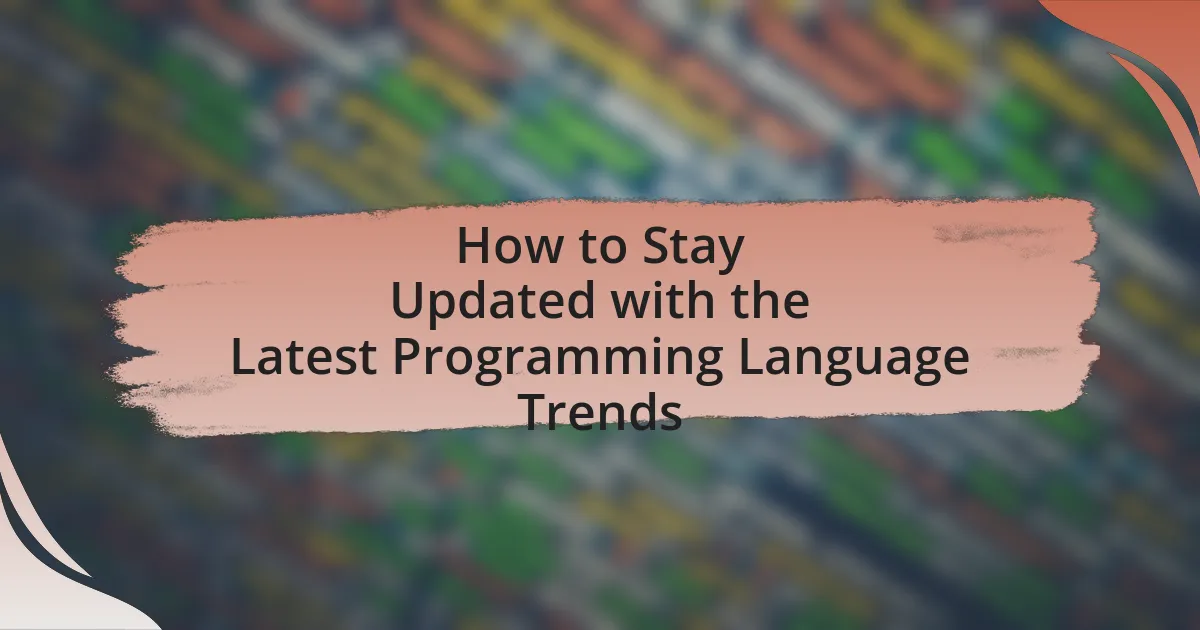The article focuses on how to stay updated with the latest programming language trends, emphasizing the importance of adapting to evolving technologies in the tech industry. It outlines key trends such as the rise of multi-paradigm languages, performance-oriented languages, and those tailored for data science and machine learning. The article also discusses the factors influencing the evolution of programming languages, the significance of community feedback, and the risks associated with not keeping up with trends. Additionally, it provides resources for tracking trends, strategies for integrating new languages into projects, and practical tips for overcoming challenges when adapting to new programming languages.

What are the Latest Trends in Programming Languages?
The latest trends in programming languages include the rise of multi-paradigm languages, increased focus on performance and efficiency, and the growing popularity of languages designed for data science and machine learning. Multi-paradigm languages like Python and JavaScript allow developers to use different programming styles, enhancing flexibility and productivity. Performance-oriented languages such as Rust and Go are gaining traction due to their ability to handle concurrent tasks efficiently and provide memory safety. Additionally, languages like Julia and R are becoming essential in data science, driven by the demand for advanced analytics and machine learning capabilities. According to the TIOBE Index, Python has consistently ranked as the most popular programming language, reflecting its widespread adoption across various domains.
How do programming languages evolve over time?
Programming languages evolve over time through a combination of community feedback, technological advancements, and the need for improved efficiency and functionality. This evolution is often driven by the introduction of new paradigms, such as object-oriented programming in the 1980s, which enhanced code reusability and organization. Additionally, languages adapt to incorporate features that address emerging challenges, such as concurrency and security, as seen with the rise of languages like Go and Rust in response to modern computing demands. Historical examples include the transition from procedural languages like C to more abstract languages like Python, which emphasizes readability and simplicity, reflecting a shift in developer preferences and industry needs.
What factors influence the evolution of programming languages?
The evolution of programming languages is influenced by technological advancements, user needs, and community feedback. Technological advancements drive the need for new languages or updates to existing ones, as seen with the rise of web development leading to languages like JavaScript and frameworks like React. User needs shape language design, prioritizing features such as ease of use, performance, and scalability; for example, Python gained popularity due to its simplicity and versatility in data science. Community feedback plays a crucial role, as developers contribute to open-source projects, leading to iterative improvements and the adoption of best practices, evident in languages like Ruby and its Rails framework.
How do community needs shape programming language trends?
Community needs significantly shape programming language trends by driving the demand for features that enhance productivity, collaboration, and problem-solving. For instance, the rise of data science and machine learning has led to increased popularity of languages like Python, which offers extensive libraries and community support tailored to these fields. Additionally, the growing emphasis on web development has propelled JavaScript and its frameworks, as developers seek tools that facilitate responsive and dynamic user experiences. The TIOBE Index and Stack Overflow Developer Survey consistently reflect these shifts, indicating that languages aligning with community needs gain traction, while those that do not may decline in usage.
Why is it important to stay updated with programming language trends?
Staying updated with programming language trends is crucial for maintaining relevance and competitiveness in the tech industry. As technology evolves, new programming languages and updates to existing ones can significantly enhance productivity, performance, and security. For instance, the rise of languages like Python and JavaScript has transformed web development, making it essential for developers to adapt to these changes to leverage their capabilities effectively. Additionally, according to the TIOBE Index, programming languages that gain popularity can lead to increased job opportunities and higher salaries, emphasizing the importance of being informed about current trends.
What are the risks of not keeping up with programming language trends?
Not keeping up with programming language trends can lead to obsolescence in skills and reduced job opportunities. As technology evolves, programming languages that are not widely adopted may become less relevant, making it difficult for developers to find employment or advance in their careers. For instance, a survey by Stack Overflow in 2021 indicated that developers using outdated languages faced challenges in securing new projects, as companies increasingly prefer modern languages that offer better performance and community support. Additionally, failing to stay updated can result in decreased productivity, as developers may struggle with outdated tools and libraries that lack the efficiency and features of newer alternatives.
How can staying updated enhance a programmer’s career?
Staying updated enhances a programmer’s career by increasing their employability and adaptability in a rapidly evolving tech landscape. As technology advances, new programming languages, frameworks, and tools emerge, making it essential for programmers to continuously learn and adapt. For instance, a survey by Stack Overflow in 2021 indicated that 70% of developers believe that keeping up with new technologies is crucial for career advancement. This ongoing education not only improves technical skills but also opens up opportunities for higher-paying positions and innovative projects, ultimately leading to career growth and job security.

What Resources are Available to Stay Updated?
To stay updated with the latest programming language trends, developers can utilize various resources such as online forums, blogs, newsletters, and social media platforms. Online forums like Stack Overflow and Reddit provide community-driven discussions and insights on emerging trends. Blogs from reputable sources, such as Medium and Dev.to, often feature articles written by industry experts discussing new languages and frameworks. Newsletters like JavaScript Weekly and Python Weekly curate the latest news and articles directly to subscribers’ inboxes, ensuring they receive timely updates. Additionally, following influential developers and organizations on platforms like Twitter and LinkedIn can provide real-time information and trends in programming languages. These resources collectively offer a comprehensive approach to staying informed about advancements in the programming landscape.
How can online platforms help in tracking programming language trends?
Online platforms can help in tracking programming language trends by providing real-time data on language usage, community discussions, and job market demands. Websites like GitHub and Stack Overflow aggregate user activity, showcasing the most popular languages based on repository contributions and questions asked. For instance, GitHub’s Octoverse report highlights trends in programming languages by analyzing millions of repositories, revealing shifts in popularity and emerging languages. Additionally, platforms like TIOBE and RedMonk publish regular indexes that rank programming languages based on search engine queries and GitHub activity, offering insights into current trends and future directions.
What are the best websites and blogs for programming news?
The best websites and blogs for programming news include Hacker News, TechCrunch, and Ars Technica. Hacker News is a social news website focusing on computer science and entrepreneurship, providing a platform for sharing and discussing the latest in technology. TechCrunch covers a wide range of technology news, including startups and programming trends, making it a valuable resource for developers. Ars Technica offers in-depth analysis and articles on technology, science, and culture, often featuring programming-related content. These sources are widely recognized in the tech community for their timely and relevant updates on programming news.
How can social media be utilized to follow programming trends?
Social media can be utilized to follow programming trends by actively engaging with relevant communities and influencers on platforms like Twitter, LinkedIn, and Reddit. These platforms provide real-time updates, discussions, and insights from industry experts, allowing users to stay informed about the latest technologies, frameworks, and best practices. For instance, Twitter hashtags such as #programming, #coding, and #devcommunity often feature trending topics and resources shared by developers. Additionally, LinkedIn groups and Reddit forums dedicated to programming topics facilitate knowledge sharing and networking opportunities, further enhancing awareness of emerging trends in the programming landscape.
What role do conferences and meetups play in staying informed?
Conferences and meetups play a crucial role in staying informed about the latest programming language trends by providing direct access to industry experts and networking opportunities. These events facilitate knowledge sharing through presentations, workshops, and discussions, allowing attendees to learn about emerging technologies and best practices. For instance, according to a survey by the Event Marketing Institute, 84% of attendees reported that conferences helped them gain insights into new trends and innovations. This direct engagement with thought leaders and peers fosters a collaborative environment where participants can exchange ideas and experiences, further enhancing their understanding of the evolving landscape in programming languages.
Which conferences are most relevant for programming language updates?
The most relevant conferences for programming language updates include the ACM SIGPLAN Conference on Programming Language Design and Implementation (PLDI), the International Conference on Functional Programming (ICFP), and the Object-Oriented Programming, Systems, Languages, and Applications (OOPSLA). These conferences are significant as they showcase the latest research, innovations, and trends in programming languages. For instance, PLDI has been a premier venue for presenting cutting-edge work in programming language design and implementation since its inception in 1979, making it a key event for professionals seeking to stay informed about advancements in the field.
How can networking at events lead to better insights on trends?
Networking at events facilitates better insights on trends by enabling direct interactions with industry experts and peers. These face-to-face conversations often reveal nuanced perspectives and emerging patterns that may not be captured in traditional media or reports. For instance, discussions at conferences can highlight real-time challenges and innovations, providing attendees with firsthand knowledge of what is shaping the programming landscape. Additionally, networking fosters the exchange of ideas and experiences, which can lead to collaborative insights that are more comprehensive and actionable. This dynamic environment encourages the sharing of best practices and lessons learned, further enhancing understanding of current and future trends in programming languages.

How to Implement Knowledge of Trends in Your Work?
To implement knowledge of trends in your work, actively integrate current programming language developments into your projects and workflows. This can be achieved by regularly reviewing industry publications, participating in relevant online communities, and attending conferences or webinars focused on programming languages. For instance, a survey by Stack Overflow in 2023 indicated that developers who engage with community forums are 30% more likely to adopt new technologies early. By applying insights gained from these sources, you can enhance your coding practices, improve project outcomes, and maintain a competitive edge in the evolving tech landscape.
What strategies can be used to integrate new programming languages into projects?
To integrate new programming languages into projects, teams can adopt strategies such as incremental adoption, training sessions, and creating interoperability layers. Incremental adoption allows teams to gradually introduce new languages by starting with small components or modules, minimizing disruption to existing systems. Training sessions equip team members with the necessary skills and knowledge to effectively use the new language, ensuring a smoother transition. Creating interoperability layers enables different programming languages to communicate, allowing teams to leverage the strengths of multiple languages without complete rewrites of existing codebases. These strategies have been successfully implemented in various tech companies, demonstrating their effectiveness in facilitating the integration of new programming languages.
How can you assess the suitability of a new language for your project?
To assess the suitability of a new programming language for your project, evaluate its performance, community support, libraries, and compatibility with existing systems. Performance metrics, such as execution speed and memory usage, can indicate how well the language will handle your project’s requirements. Community support is crucial; a strong community often means better resources, documentation, and troubleshooting assistance. The availability of libraries and frameworks can significantly reduce development time and enhance functionality. Lastly, ensure that the new language is compatible with your existing systems to avoid integration issues. For instance, languages like Python and JavaScript have extensive libraries and strong community support, making them suitable for various projects.
What are the best practices for transitioning to a new programming language?
The best practices for transitioning to a new programming language include thorough research, hands-on practice, and leveraging community resources. First, researching the language’s syntax, paradigms, and ecosystem helps establish a foundational understanding. Engaging in hands-on practice through small projects or coding exercises reinforces learning and builds confidence. Additionally, utilizing community resources such as forums, documentation, and tutorials provides support and insights from experienced developers. These practices are supported by studies showing that active engagement and community involvement significantly enhance the learning curve when adopting new programming languages.
What are some common challenges when adapting to new programming languages?
Common challenges when adapting to new programming languages include syntax differences, varying paradigms, and unfamiliar libraries or frameworks. Syntax differences can lead to errors and confusion, as each language has its own rules and conventions. For instance, transitioning from Python to Java requires understanding Java’s strict type system and syntax structure. Varying paradigms, such as procedural versus object-oriented programming, can complicate the learning process, as developers must adjust their thinking and problem-solving approaches. Additionally, unfamiliar libraries or frameworks may hinder productivity, as developers need to invest time in learning new tools and their functionalities. These challenges are well-documented in programming education literature, highlighting the importance of structured learning and practice when transitioning between languages.
How can you overcome the learning curve associated with new languages?
To overcome the learning curve associated with new languages, engage in consistent practice and utilize immersive learning techniques. Consistent practice reinforces language concepts and builds familiarity, while immersive techniques, such as coding in real-world projects or participating in coding communities, enhance understanding and retention. Research indicates that active engagement, such as pair programming or contributing to open-source projects, significantly accelerates the learning process, as learners apply theoretical knowledge in practical scenarios.
What resources can assist in troubleshooting issues with new languages?
Online forums such as Stack Overflow and Reddit are valuable resources for troubleshooting issues with new programming languages. These platforms allow users to ask specific questions and receive answers from experienced developers, fostering a community-driven approach to problem-solving. Additionally, official documentation and language-specific websites provide comprehensive guides and troubleshooting tips directly from the language creators, ensuring accurate and up-to-date information. For example, the Python Software Foundation offers extensive documentation that includes troubleshooting sections, which can be crucial for resolving common issues.
What are some practical tips for staying updated with programming language trends?
To stay updated with programming language trends, regularly follow reputable tech blogs, subscribe to newsletters, and participate in online communities. Reputable tech blogs like TechCrunch and Smashing Magazine provide insights into emerging languages and frameworks. Newsletters such as JavaScript Weekly and Python Weekly curate the latest developments in their respective languages. Engaging in online communities, such as Stack Overflow and Reddit, allows developers to discuss trends and share resources. Additionally, attending conferences and webinars can provide firsthand knowledge of industry shifts and innovations. These methods ensure that developers remain informed about the evolving landscape of programming languages.

Leave a Reply